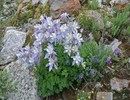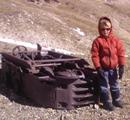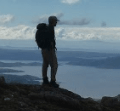In search of tips for descending scree
Forum rules
- This is a mountaineering forum, so please keep your posts on-topic. Posts do not all have to be related to the 14ers but should at least be mountaineering-related.
- Personal attacks and confrontational behavior will result in removal from the forum at the discretion of the administrators.
- Do not use this forum to advertise, sell photos or other products or promote a commercial website.
- Posts will be removed at the discretion of the site administrator or moderator(s), including: Troll posts, posts pushing political views or religious beliefs, and posts with the purpose of instigating conflict within the forum.
-
RhodoRose

- Posts: 183
- Joined: 8/21/2015
- 14ers: 58
- 13ers: 12 3
- Trip Reports (0)
Re: In search of tips for descending scree
Poles and microspikes. Especially if you have a bad knee (like I do).
But one thing I do: Forgetting what is behind and straining toward what is ahead, I press on toward the goal to win the prize for which God has called me heavenward in Christ Jesus.
Philippians 3: 13-14
Philippians 3: 13-14
-
mtree

- Posts: 1625
- Joined: 6/16/2010
- Trip Reports (0)
Re: In search of tips for descending scree
I think more experience is in order.
Huron and Princeton aren't covered in scree. Just some rocky and rugged sections. I NEVER use poles in rocks. I end up depending on them for balance and that's not what I need in rocky sections. My center of gravity is too high keeping me from bending my knees and balancing without using a "crutch". Plus they get stuck in the cracks and that's annoying. Just practice more on steep and rocky terrain. You'll figure it out.
And as someone mentioned, leaning back is NOT what you should be doing.
Huron and Princeton aren't covered in scree. Just some rocky and rugged sections. I NEVER use poles in rocks. I end up depending on them for balance and that's not what I need in rocky sections. My center of gravity is too high keeping me from bending my knees and balancing without using a "crutch". Plus they get stuck in the cracks and that's annoying. Just practice more on steep and rocky terrain. You'll figure it out.
And as someone mentioned, leaning back is NOT what you should be doing.
- I didn't say it was your fault. I said I was blaming you.
Re: In search of tips for descending scree
I usually reserve the word scree to mean "everything moves at least slightly", not just rocky steep terrain. I found that skiing and parkour (used to be pretty into it back in the day) made me substantially more efficient at going down this stuff.
Just like skiing, keep your feet pointed across the slope and body facing downhill if you're not trying to go fast, do not let your weight onto your back foot too much. I often imitate the pole plant motion even on somewhat stable steep terrain.
Assume the rocks are going to move and make a guess as to how they will do that before you step, subconsciously. Then you will more often be prepared to react, and hopefully figure out how to step on them without moving.
Prepare to eat it sometimes if you want speed. Descending choss can be super fun, some of my best moments in the mountains! I love choss!!
Just like skiing, keep your feet pointed across the slope and body facing downhill if you're not trying to go fast, do not let your weight onto your back foot too much. I often imitate the pole plant motion even on somewhat stable steep terrain.
Assume the rocks are going to move and make a guess as to how they will do that before you step, subconsciously. Then you will more often be prepared to react, and hopefully figure out how to step on them without moving.
Prepare to eat it sometimes if you want speed. Descending choss can be super fun, some of my best moments in the mountains! I love choss!!
-
nyker

- Posts: 3391
- Joined: 12/5/2007
- 14ers: 58
- 13ers: 25
- Trip Reports (69)
Re: In search of tips for descending scree
In addition to the other suggestions; you don't mention your overall fitness, but perhaps more strength training for your legs could help make your legs stronger and feel less tired descending. It may also help any knee issues which might result from a weaker VMO, making a descent harder or possibly more unstable, making the downward trip trickier for you otherwise.dirtgrl wrote: ↑Sun Dec 01, 2024 9:00 am Hello! I usually am very slow hiking down loose scree sections, sometime squatting low or sliding on my tushie to get down. I often "overuse" my poles, relying on them too much where balance and confidence would be a safer choice. For example, I slid most of my way down the uppermost sections of Princeton and Huron where others around me were safely walking down.
Do you have tips or suggestions for increasing my confidence to walk down safely? Are there any exercises or areas to practice that you recommend?
Thank you!
Re: In search of tips for descending scree
Skis. On snow.
Traveling light is the only way to fly.
IG: @colorado_invasive
Strava: Brent Herring
IG: @colorado_invasive
Strava: Brent Herring
-
jrbren_vt

- Posts: 711
- Joined: 2/18/2006
- 14ers: 17
- 13ers: 41
- Trip Reports (0)
Re: In search of tips for descending scree
I think we are talking about stuff like the main Blodgett peak trail in Colorado Springs. Basically very steep kitty litter quality terrain that goes on & on, like hiking on ball bearings. My first few times descending that trail I took several spills. There are many trails like this in Colorado I have found, but that one is probably the worst. Others have already covered my solutions : 1.) Make sure your hiking boots or shoes have good tread on them, it makes a huge difference. 2.) Or use an old beater pair of micro spikes that it is OK to wear the tips down 3.) Trekking poles 4.) These trails are much easier in winter when the ground is frozen and all the loose shite is bonded together. And you are probably wearing your spikes anyway for the ice.
*****************
Best Regards
*****************
Best Regards
*****************


